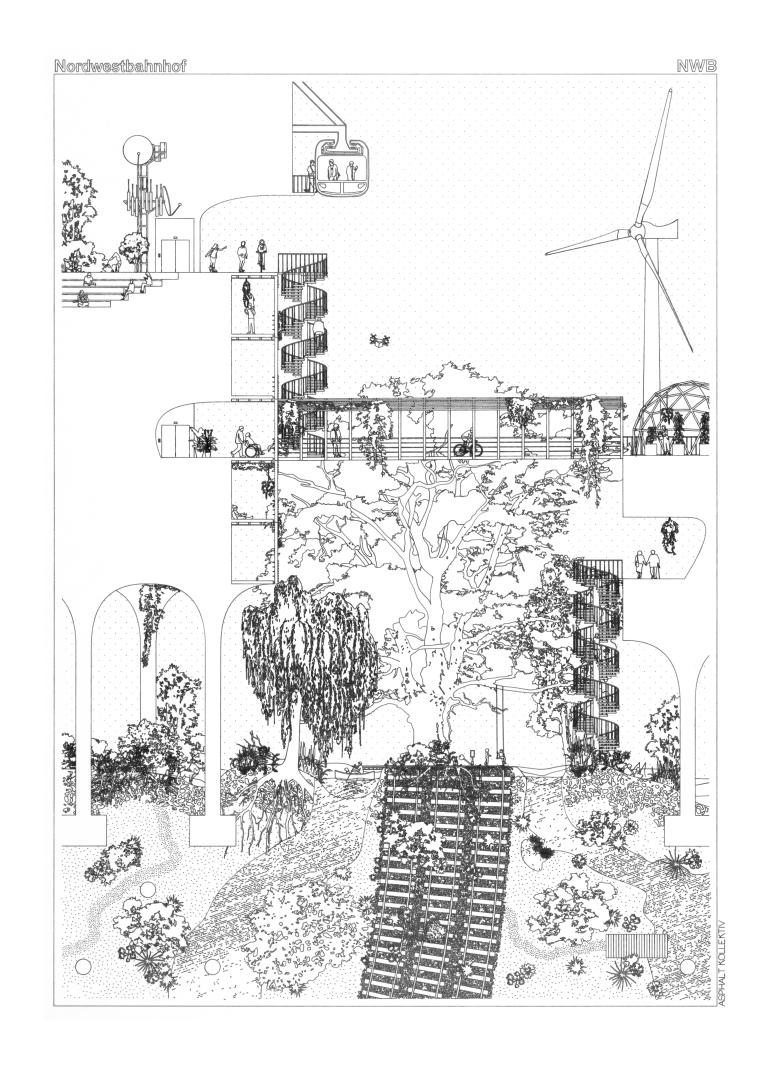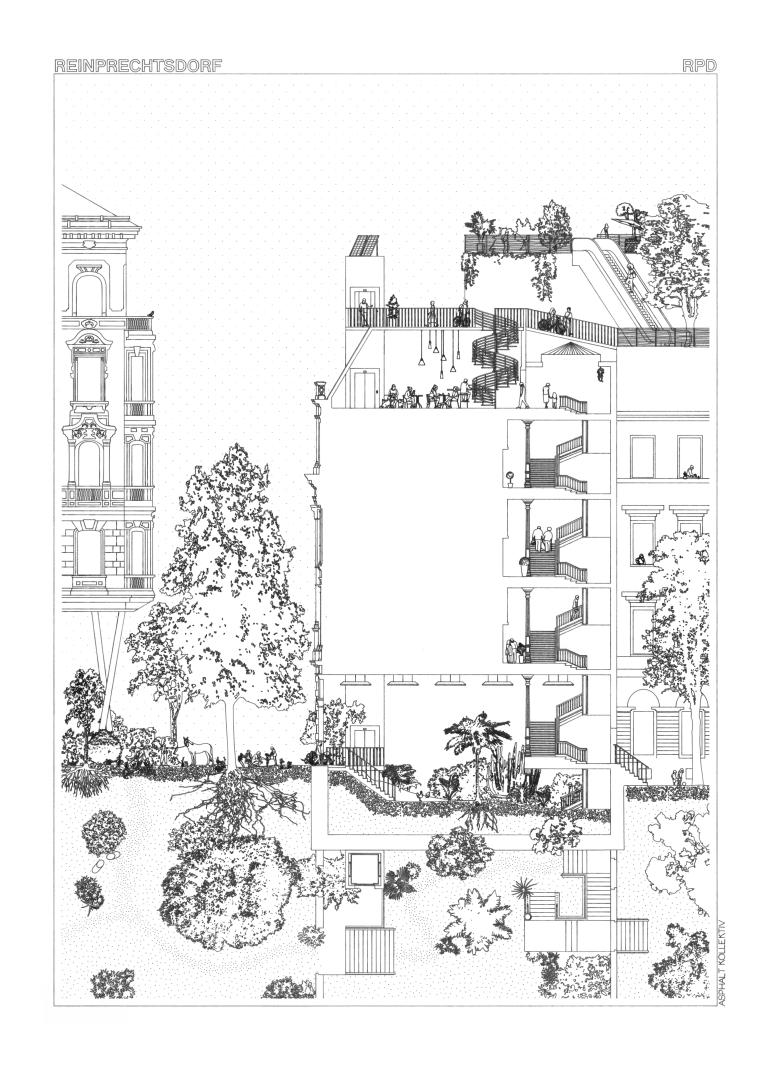Terrestrial Fields in Urban Conditions
Basic information
Project Title
Full project title
Category
Project Description
“Terrestrial Fields in Urban Conditions” propose a reorientation and broadening the objectives of the goals and approaches for the ecological transformation of urban development. This new approach to space production is called “Terrestrial Fields”. They represent urban experimental fields, implemented through the urban planning instrument of zoning. A habitat for all species; places of co-evolution, between humans, animals and plants, where the landscape extends into the city and not vice versa.
Project Region
EU Programme or fund
Description of the project
Summary
With the project “Terrestrial Fields in Urban Conditions” we propose a reorientation and broadening the objectives of the goals and approaches for the ecological transformation of urban development.
The project considers the city as a symbiotic entity with its mutual conditionalities between human civilization, flora and fauna. It no longer sees any contradictions between culture and nature, but establishes an open dialogue.
In the history of the city, there have always been major identity-forming interventions. Today, new innovative impulses are needed for a forward-looking ecological and social development of the city.
We call these new approaches to the production of urban space “Terrestrial Fields”: A habitat for all species, places of co-evolution, between humans, animals and plants, where the landscape extends into the city and not vice versa.
"Terrestrial Fields" are implemented through the urban planning instrument of zoning and are envisioned as a new zoning category.
The new zoning “Terrestrial Fields” gives a special place to nature in the city. They represent a protected zone that includes the processes in the earth, as well as the flora and fauna. The “Terrestrial Fields” are decentralized experimental fields in the city, which operate at different scales and can be applied in a variety of spatial situations. They can be used in the redesign of streets and courtyards, roof extensions or conversions in the first-floor zone, in gaps between buildings, as well as in the designation of new urban development areas.
Over time, these areas, designated as “Terrestrial Fields”, form a green network to meet the challenges of climate change and the ecological transformation of the city.
Key objectives for sustainability
In Terms of sustainability the project “Terrestrial Fields in Urban Conditions” pushes the unsealing of the ground.
Sealing destroys the natural, ecological functions of soils. Open soils have the ability to store and evaporate water, as well as to filter, bind and break down pollutants. Unsealed soils thus make a decisive contribution to combating climate change by acting as cold islands that balance out urban climatic conditions. The areas dedicated as “Terrestrial Fields” implement a complete unsealing. By consistently creating unsealed areas, vegetation cover is created on the ground. The resulting evaporation processes contribute to cooling the urban space and the surrounding buildings and serve as natural air conditioning for the buildings. The Terrestrial Fields thus strongly counteract the development of "urban heat islands". Green spaces in urban areas not only have an important function with regard to precipitation water retention and water evaporation with the associated cooling effects, but also for precipitation water infiltration and groundwater recharge. Topics of major importance due to the predicted scenarios of heavy rainfall and flooding in European regions in 2050. As well the importance of humic soil layers for water filtration has to be pointed out.
The network of “Terrestrial Fields” will make the city more resilient for predictable and unpredictable events in future.
Key objectives for aesthetics and quality
The “Terrestrial Fields” shall spread over the whole urban space. These creates green structures that can be experienced, creating a new identity for the public space and, by extension, the city. The “Terrestrial Fields” are not a park in the common sense but more like spaces with wilderness character.
The elevation of the building development results in completely new building typologies. The structures are predominantly made of wood, a sustainable building material.
Through the sun, wind and rain, the vegetation in these “Terrestrial Fields” creates a unique play of light and shadow, creating a spectacle for all senses. The perception will shift, the city will be dominated by totally different sounds and smells than today.
Key objectives for inclusion
What the climate crisis shows best is our dependence. Therefore, the project “Terrestrial Fields in Urban Conditions”, propose urban experimental fields in which flora, fauna and human civilization have equal rights. Non-human species are acknowledged as actors in the city. This new approaches to space production converge in the “Terrestrial Fields”.
In the “Terrestrial Fields”, humans have the right to enter without the right to demarcate, appropriate or own. The transit is possible through trample paths. Humans learn about their dependance through observing. Schools will go there to learn about biology. Elderly people will use the cool spaces for their afternoon exercises and walks. Young adults care for the “Terrestrial Fields” in their voluntary social year. University research projects will take place.
Diverse possibilities of use and a heterogeneous user group is targeted for the building development in combination with the Terrestrial-Fields-Zoning. Since the “Terrestrial Fields” are spread over the whole city not only wealthy parts profit from these interventions.
Innovative character
The innovative character of the concept is the equal treatment of all city actors as well as the handling of the resource of land and soil. We have to acknowledge our dependance and that humans only can develop in relationship to other species. The active inclusion of the needs of other living beings and social participation is at the center of the project: A new form of co-evolution and co-habitation. At the same time the projects also bring more equality to people. The increasing heat in our cities affects especially elderly people, people with cardiovascular diseases, people in poorer areas who have less access to green space or cannot afford air conditioning in their homes.
Both topics, the privatization of the land and equal rights for all species are highly political and have to be treated if we want to tackle the climate change.


